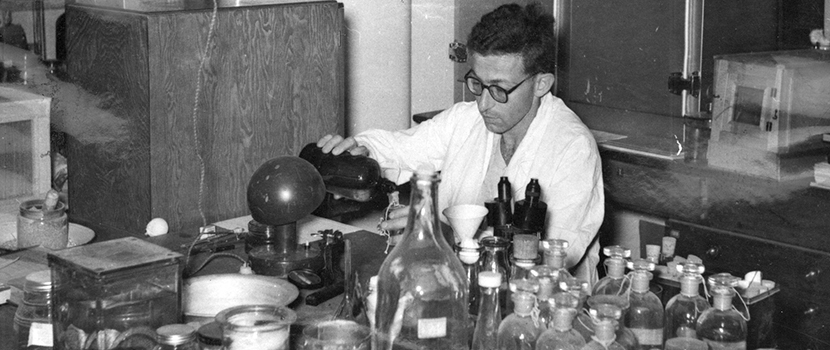Early Days
In 1925, the founding year of the Hebrew University of Jerusalem, the Botanical Department was established in Tel-Aviv as part of the "Institute for the Study of the Nature of the Land of Israel". In 1929 the department was transferred to the university campus on Mount Scopus in Jerusalem. The initial faculty members included Prof. Otto Warburg (head of the department) and Dr. Alexander Eig, who were joined soon after that by Michael Zohary and Naomi Feinbrun. The trio of researchers Eig, Zohary and Feinbrun focused on the study of the flora of the Land of Israel and its neighbors. They established the Herbarium (now part of the National Natural History Collections) and the botanical garden in Mount Scopus, which was the first botanical garden in Palestine and the entire Middle East. Based on this work, in 1931 they published The Analytical Flora of Palestine – the first comprehensive systematic study of plants in the Land of Israel. Later, Prof. Tcharna Reiss, Prof. David Zaitschek and Prof. Michael Even-Ari joined the department, expanding the scope of the department's research.
In 1928 Prof. Shimon Bodenheimer established the Department of Zoology. Within a few years, Prof. Israel Aharoni, Prof. Georg Haas and Prof. Karl Reich joined the department and extended its activity. Biology teaching at the Hebrew University began only in 1932/33.
The work of the founding researchers laid the basis for the contemporary activities of the Institute of Life Sciences on three fronts:
- In-depth academic research, which addresses a variety of processes and mechanisms, integrates and links the various organizational levels in the animal and plant world, and integrates basic research with applied aspects in the fields of biomedicine, biotechnology and agriculture.
- Teaching at a high academic level, presenting the variety of disciplines in the life sciences, with an emphasis on critical and creative thinking and experience in data collection and processing skills in scientific research.
- Establishing mutual relations between researchers and the general public, who are interested in various aspects of the life sciences and their relevance to the daily lives of us all.

The War of Independence
Immediately after the UN vote on the Partition Plan (29.11.1947), it became impossible to operate permanent and safe transportation to and from Mount Scopus. Consequently, some of the researchers managed to transfer their equipment from Mount Scopus to various buildings in the city center and even to their private homes. In addition, many members of the academic staff and students joined the fighting forces, so that research and teaching gradually decreased in the coming months, until they were completely discontinued following the fatal attack on the Hadassah convoy on its way to Mount Scopus (April 13, 1948). This convoy included medical staff and patients of Hadassah Hospital, Hebrew University employees and students and Haganah members. Seventy-eight of the convoy's passengers were killed when the convoy was attacked in the Sheikh Jarrah neighborhood by Arab forces. Researchers of the Botany Department who were supposed to join the convoy were saved from the fate of their colleagues, because they postponed their voyage to Mount Scopus to attend the wedding of their friend, botanist Avraham Fahn.
Following the war, studies were resumed at the Hebrew University only in April 1949.
After the War of Independence
Following the Israeli-Jordanian armistice agreement in 1949, Mount Scopus, including the campus of the Hebrew University, became an Israeli exclave within Jordanian territory. Since research and teaching could not take place there anymore, academic activities were conducted in numerous sites throughout Jerusalem. For example, the Departments of Botany and Zoology were first housed in the Terra Santa building, and then moved to the Italian convent of San Antonio on Jabotinsky Street and a number of prefabricated huts on the opposite hill (now the President's Residence). Later, the newly formed Department of Genetics also resided in the convent building.
In the 1950s, the Givat Ram campus was established, and most of the university's activities moved there (except for the Faculties of Medicine and Agriculture). The Botany Department was the first to move to the pavilions adjacent to the Canada Hall in Givat Ram. In 1965, the Jerusalem municipality confiscated the area adjacent to the San Antonio convent for the President's Residence, forcing the Department of Zoology to move to the Russian Compound, whereas the Department of Genetics remained in the Italian convent.
In the 1960s, following the recommendation of a special committee appointed by the rector at the time, Prof. Julio Racah, the Faculty of Mathematics and Natural Sciences was reorganized in the frame of five main institutes: mathematics, chemistry, physics, life sciences and earth sciences. Following this decision, the various biological departments were unified in 1967 within the Institute of Life Sciences, along with the Department of Biological Chemistry, which until then had belonged to the Chemistry School, and was located in Mamila. During the 1970s, the Department of Neurobiology was also located in the Russian Compound.
The construction of a central building for the Institute of Life Sciences in Givat Ram campus started in 1968. In 1976 the institute was named for Alexander Silberman, founder of Penn Corporation in Philadelphia. The new building was inaugurated in 1978. At the initiative of Prof. Daniel Zohary, the botanists and zoologists involved in "wet" research moved into the main building, while their colleagues studying population biology, together with the National Natural History Collections, were housed in the Berman-Sturman buildings, and in 1985 formed the Department of Evolution & Ecology, which later became the Department of Ecology, Evolution & Behavior.
